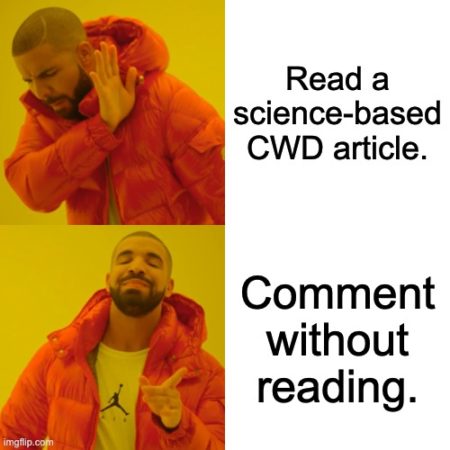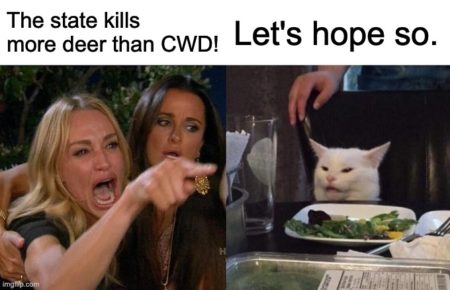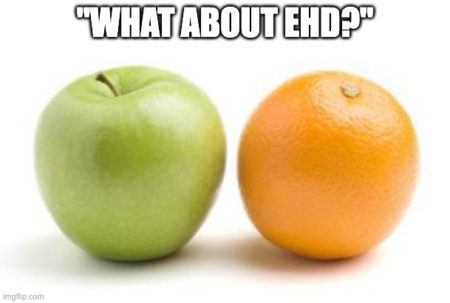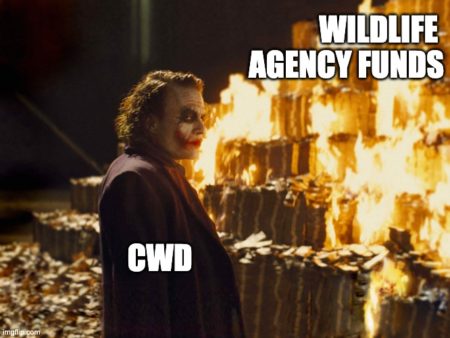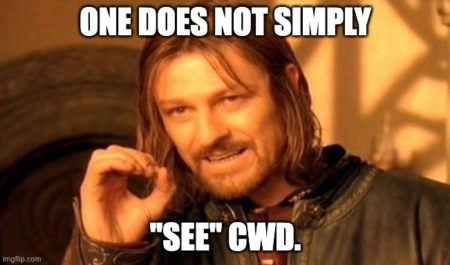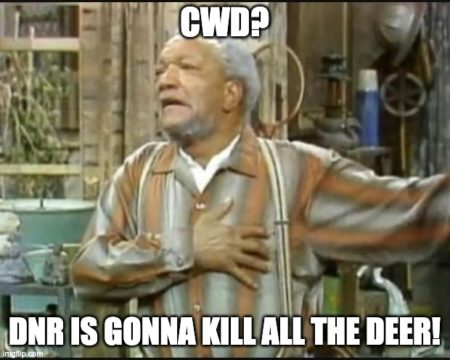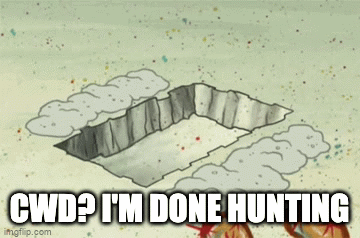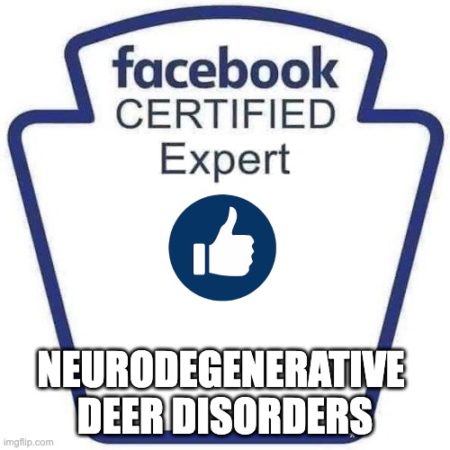Despite the continual advancement of internet technology, we’ve failed to improve one particular area of websites and social media. Like a forest full of noxious invasive plants, “comments” remain a polluted ecosystem overrun by trolls, know-it-alls, bullies, bots, conspiracy theorists and other toxic personality types. They post their hot takes where all of us can see them, giving these people an outsized impact on public dialogue that exceeds their demographic importance. Nowhere is this more visible in the deer hunting world than when chronic wasting disease is the topic of discussion.
Whenever NDA or other groups genuinely concerned about this deer disease share valid, science-based information on social media, the comments are sure to instantly fill up with scornful, cynical or downright angry posts. You’ll see anti-government and anti-science conspiracy theorists, opportunistic trolls, as well as a few folks who didn’t read the article and don’t know much about the subject but are going to comment anyway because bandwagon. Regardless of their origins, these commenters know everything there is to know about CWD. As one bystander in a recent thread observed sarcastically, “Look at all these wildlife biologists up in here.”
Public opinion polls show the majority of deer hunters are concerned about CWD, and most want to know how they can help in this fight. It would be easy enough to repeat some simple and useful pieces of advice like “Don’t read the comments” and “Ignore the trolls.” But I suspect CWD deniers are preventing some media outlets and influencers from sharing educational CWD information. They don’t want to deal with the trolls, so they just don’t go there. We all need to learn to see beyond the noise, because it’s the same people with the same tired talking points and worn-out arguments every time. And most of their greatest hits are laughably incorrect.
The National Deer Association relies on reliable, peer-reviewed science as the foundation of our work and our educational content. Sometimes that means taking unpopular positions because the biological science doesn’t match social or political whims or misinformation that is being deliberately circulated. While there is much room for debate over CWD management, we cannot manage a natural resource like deer when some stakeholders refuse to acknowledge science and arrive at the debate committed to disruption. I’ve heard the best way to deal with conspiracy theorists is empathy, and I believe that’s true if there’s one among your close friends or family. But in public debate and discussion, the future of our deer resource is too important for us to coddle and console people who refuse even to consider basic scientific principles of wildlife management. Despite the trolls, we are continuing to reach out to reasonable, open-minded deer hunters with the facts, and we’ll continue to recruit them for a coalition of stakeholders that is fighting for deer.
So, here’s a look at nine CWD commenters who show up reliably at every CWD debate, and why they should be ignored while the rest of us continue the fight.
The Cure-Is-Worse Whiner
This guy says things like “State agencies have killed more deer trying to stop CWD than CWD ever killed or ever will.” To which I say: “Amen!” That’s the idea! I fervently hope that management efforts kill more deer than CWD ever does. If you reach the point that CWD is killing more deer than are being harvested by hunters or the state agency, you’re up CWD Creek without a paddle. Avoiding this scenario is the whole point of a surgical harvest strategy called “targeted removal.”
People who make even a minimal effort to understand targeted removal learn that this method allows agencies to stay dialed-in on the locations of most CWD-positive deer. Then, focused harvest management in those local areas helps keep the infection rate low in the population as long as you sustain close monitoring and harvest management. It’s also important to note that post-season targeted removal in a CWD zone isn’t necessary if hunters meet the state’s harvest and testing goals first, during hunting season. In CWD zones where active management occurs, greater than 90% of hunter-harvested deer are testing clean, and that’s a deer population that will continue to be able to sustain hunter harvest. When targeted removal is necessary, actual numbers of deer removed in such operations are small, but it is effective because it’s targeted and based on previous intelligence about locations of positive deer. The alternative is to do nothing and simply let CWD spread and rise in prevalence. We cannot wait until CWD has infected high percentages of deer in any area before we deem that action is acceptable. At that point, it’s far too late to manage your way back to a sustainable situation.
The “What-About-EHD” Distractor
A doctor informs a patient that samples taken from that bulge on the patient’s neck came back malignant. This commenter would respond with, “What about heart attacks? They kill more people!”
Just like heart attacks, EHD is a serious concern. Just like cancer, chronic wasting disease is a serious concern in its own right. The existence of one does not nullify the other; we are capable of studying, learning about and attempting to manage both. Yes, EHD has killed a lot of deer historically. However, CWD spreads and kills slowly, so it is future mortality that is a concern, and the potential damage grows each day we delay action in a CWD outbreak area. In fact, if you’re going to compare these two diseases, CWD has a very positive feature that EHD does not: We can manage CWD if we try! EHD is a phantom virus that strikes and vanishes, and we cannot predict the location or intensity of the next appearance. We cannot control the insects that spread the virus, and we can’t stop deer from being bitten by them.
However, with CWD, we can take several actions to slow the spread of the disease, such as banning the transportation of live deer and stopping the movement of deer carcasses out of CWD zones. In areas where it is established, we can suppress infection rates to low levels through testing, monitoring, managed harvest, and targeted removal.
The Insurance Company Conspiracy Theorists
This is the commenter who lazily posts an old stand-by: “This is just a scheme by the insurance companies.” Ah yes, the oldest and most villainous boogeyman in hunting conspiracy lore: the evil, ninja-like insurance companies! Long before CWD came along, conspiracy-minded deer hunters were blaming insurance companies for any real or perceived affliction, so it has worked out conveniently for them to just adapt a classic conspiracy theory to a new grievance.
It’s a futile task for a rational person to try to make sense of a conspiracy theory, but I think the contorted logic of this fairy tale is that insurance companies don’t like deer because of deer/vehicle collisions, therefore they have all joined forces in an unholy risk-management mafia to end deer for good. Deep in their hidden laboratory, insurance companies developed some of the most evil ideas in history, like earn-a-buck regulations. There they bred new strains of coyotes and released them secretly throughout the eastern states.
It’s noteworthy, of course, that insurance companies are operating the most inept conspiracy in American history. After all their decades of diabolical schemes, we have more whitetails today than ever, and our annual deer harvest has hovered at record levels for more than 20 years. Whatever the insurance companies are doing in that underground base, can we help them do more of it?
The Money Managers
There seem to be a lot of financial wizards among CWD commenters. They’re the ones who quickly label CWD as “just a money-making ploy.” This “money making” theme is another old favorite among conspiracy theorists of all kinds, and it’s a quick go-to for any uninformed person who wants to attack information they don’t like but can’t discredit intelligently. “Yo, this is just about the money.”
Yes, large amounts of our tax dollars and agency staff time are being redirected from other priorities to be spent on CWD testing, monitoring, education and management. I’d much rather see conservation dollars spent on public-land habitat improvement, wildlife law enforcement, and the like – and so would all of the wildlife agency personnel who must make these decisions. Many of them are deer hunters like you and me. But for all the reasons I touch on in this and other articles I’ve written, we must address CWD. Failing to spend money on monitoring, research and management of CWD is not an option. But the idea that our professional wildlife managers are profiting from these decisions is simply silly.
If you’re concerned about the money, the best thing you can do is help stop the spread of CWD to new areas and support research that will eventually help us find solutions.
NBD Man
This guy will tell you CWD is NBD (no big deal) because he hunts in a CWD area and hasn’t seen a sick or dead deer yet. Yeah, that’s not how it works. SMH.
Once you understand the nature of CWD, you understand why it doesn’t fill the woods with decaying deer carcasses, like a bad outbreak of EHD can. I’ve talked to numerous hunters in CWD zones who don’t “see” CWD in the form of sick deer and dead-heads. They see it in the CWD-positive test results for harvested deer that looked completely healthy. I wrote a separate article about this.
This is CWD’s disguise that allows it to fool so many hunters into denial. It’s a stealthy, creeping poison, not a lightning strike. If you walk through the woods of a CWD zone looking for evidence to jump out and grab you, you might also be lulled into thinking like NBD Man.
The Drama Queens
These commenters are always staggering back, clutching their hearts and calling out “It’s the Big One!” as they accuse state agencies of “killing all the deer!” Never mind that sampling and targeted-removal efforts are effective with very minimal numbers of deer harvested — far, far fewer than hunter harvest. Don’t try to interrupt the melodrama with facts. Whatever the actual number of deer removed, it’s always “all of them” in this performance.
To hold the spotlight with their hysterics, these tragedians will trust hearsay over lots of available data. State agencies will show you exactly how many deer they removed in a particular CWD zone and when. Often it’s available on their website. But the Drama Queen’s cousin’s girlfriend’s hairdresser’s uncle posted on Facebook that he saw a suspicious unmarked van like the kind that might be transporting tactical anti-deer SWAT snipers. No amount of science or data and no qualified expert is going to close the curtains on these performers.
The Quitters
Upon learning CWD has been discovered near them, or in the county they hunt, these folks comment with: “Well, that’s it, I’m done hunting.”
There’s no need for such an extreme reaction. Deer hunting continues on in all the areas where CWD has been found. It must, because hunters and hunting are the number one tool for monitoring and managing the disease.
When you get your deer tested for CWD in these zones, as you should, you will sometimes learn you killed an infected animal. You should not eat this venison, and that’s not happy news, but the bright side is this: You removed one more infected deer from the landscape. You are helping keep infection rates low in your area. Collect your replacement tag and continue on, hopefully bagging a healthy deer for your freezer. Meanwhile, save your “CWD detected” notification as a badge of valor from the fight against CWD.
The Scare Tactic Experts
I see the phrase “scare tactic” wielded regularly by those who dismiss the CWD issue. They say things like “It’s just a scare tactic to end deer hunting” or to achieve some other random non-sensical goal. The “scare tactic” dismissal is common in the broader conspiratorial world. Generally a “scare tactic” really means “Something I don’t understand but refuse to learn more about before commenting.”
There’s no doubt that some media outlets have covered CWD in a way that makes it seem more frightening or disastrous than it really is. I cringe when national news outlets cover CWD, because alarming headlines drive more clicks – thus was born the ridiculous “zombie deer” nickname. And I know that many deer hunters are weary of even seeing the acronym “CWD” on social media or in headlines. I am too. I wish it would all go away and never trouble us again. The good news is that reality lies somewhere between “It’s not a problem” and “It’s the end of deer hunting.”
For our part, NDA is not trying to scare anyone into anything. We just want deer hunters to understand that there’s an effort underway to fight CWD, and they can help. If you see “scare tactic” headlines, just remember there’s no need to fear CWD if you understand it. We know ways to fight it, and we’re learning more every day.
The Darwinians
Every comment section below a CWD article is filled with “experts” on neurological disorders of wildlife who are never too busy to sit at their keyboards and spill their vast “knowledge.” Among them are the evolutionary biologists who endorse hands-off approaches like “Let nature take its course” and “survival of the fittest will fix this.”
We have real-world case studies of the do-nothing approach, and it isn’t pretty. Wisconsin was the first state east of the Mississippi River to find CWD, and the political forces in that state decided early on to prevent the state wildlife agency from doing anything about CWD, so they let nature take its course. Over the years, infection rates in impacted areas have climbed steadily, and the disease has spread to many new counties. Meanwhile, next door in Illinois, infection rates have remained mostly flat over the same number of years because they are taking active steps to target and remove CWD-positive deer.
Darwinian “survival of the fittest” is a slow process that takes centuries or millennia to work. We have to address this problem in our lifetimes to ensure sustainable deer harvests even in the presence of the disease. Active management can work, but only if deer hunters and state wildlife agencies tackle the problem together. Do-nothing deer hunters need to become extinct.
There you have nine of the most familiar CWD deniers on social media. They will not stop this organization from continuing to share reliable information so that hunters can join the fight against this disease. In fact, every time they comment, we grow more committed to this mission. And they shouldn’t stop you from deer hunting, learning more about CWD, listening to qualified experts, asking legitimate questions when you want to understand, or from engaging in the effort to manage and fight this disease.

